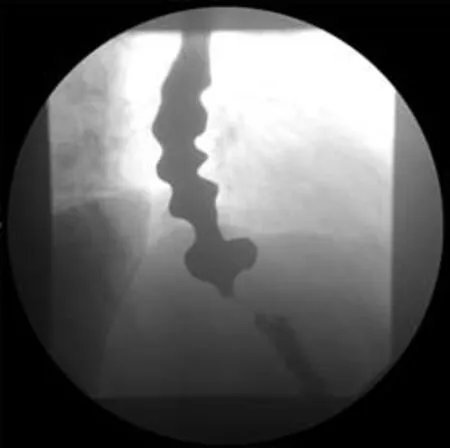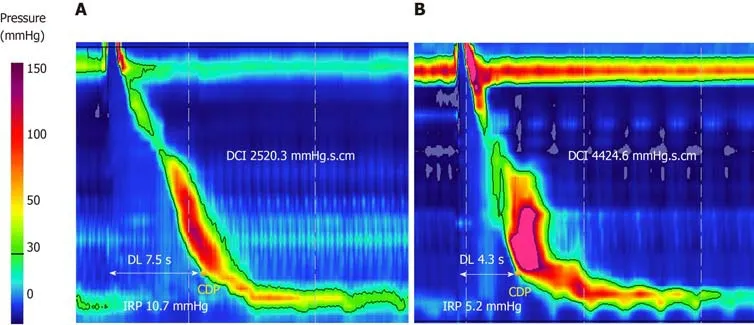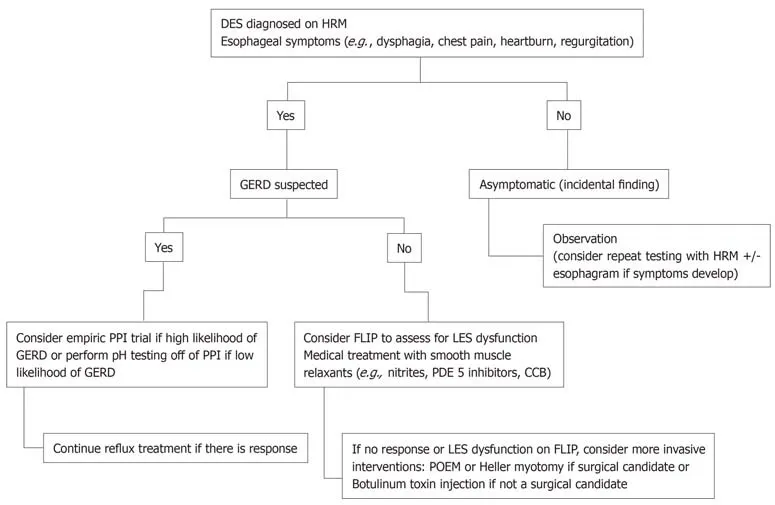Distal esophageal spasm: Update on diagnosis and management in the era of high-resolution manometry
Harika Gorti,Salih Samo,Nikrad Shahnavaz,Emad Qayed
Harika Gorti,Department of Medicine,Atlanta Veteran Affairs Medical Center and Emory University School of Medicine,Atlanta,GA 30322,United States
Salih Samo,Nikrad Shahnavaz,Emad Qayed,Department of Medicine,Division of Digestive Diseases,Emory University School of Medicine,Atlanta,GA 30303,United States
Abstract
Distal esophageal spasm(DES) is a rare major motility disorder in the Chicago classification of esophageal motility disorders(CC).DES is diagnosed by finding of ≥ 20% premature contractions,with normal lower esophageal sphincter(LES)relaxation on high-resolution manometry(HRM) in the latest version of CCv3.0.This feature differentiates it from achalasia type 3,which has an elevated LES relaxation pressure.Like other spastic esophageal disorders,DES has been linked to conditions such as gastroesophageal reflux disease,psychiatric conditions,and narcotic use.In addition to HRM,ancillary tests such as endoscopy and barium esophagram can provide supplemental information to differentiate DES from other conditions.Functional lumen imaging probe(FLIP),a new cutting-edge diagnostic tool,is able to recognize abnormal LES dysfunction that can be missed by HRM and can further guide LES targeted treatment when esophagogastric junction outflow obstruction is diagnosed on FLIP.Medical treatment in DES mostly targets symptomatic relief and often fails.Botulinum toxin injection during endoscopy may provide a temporary therapy that wears off over time.Myotomy through peroral endoscopic myotomy or via surgical Heller myotomy can provide long term relief in cases with persistent symptoms.
Key words:Distal esophageal spasm;High-resolution manometry;Esophagus;Functional lumenal imaging probe;Spastic achalasia;Esophageal motility
INTRODUCTION
The symptoms of distal esophageal spasm(DES) were first clinically described by Dr.Osgood[1]in 1889.He described six patients with symptoms of sudden chest pain and dysphagia during eating,with eventual sensation of passage of food to the stomach.In 1934,Moersch and Camp[2]used the term “Diffuse spasm of the lower part of the esophagus” to describe findings of abnormal contractions in 8 patients with chest pain and dysphagia.Since then its definition had undergone revision over time with technological advances and improvements in diagnostic evaluation techniques up until its latest definition in the Chicago classification of esophageal motility disorders(CCv3.0) using high-resolution manometry(HRM)[3,4].Initial reports of this disorder noted tertiary esophageal contractions on esophageal barium studies,which at time held no clinical significance.However,with the increasing occurrence of these findings with symptoms of dysphagia and substernal chest pain[5],this clinical syndrome was later classified as DES.The earliest studies establishing diagnostic criteria characterized the predominant feature of DES to be powerful simultaneous contractions followed by repetitive spasms with intermittent primary peristalsis[5,6].Later on,with new technological advances and manometric evaluation techniques the definition of DES was revised.In addition to the initial diagnostic feature of simultaneous contractions with intermittent normal peristalsis,an additional criterion of contractions being present for more than 10% of wet swallows was added as it was observed that healthy controls may have such features but with frequency < 10% of swallows[4].However,the above definitions created a large heterogeneity to this disorder.
The invention of HRM in 2000 significantly improved the ability to understand and evaluate esophageal motility disorders including DES[7].Multiple studies have been conducted to help decipher the various aspects of this esophageal motility disorder.Currently,the specific characteristics of DES on HRM are premature contractions(≥20% of wet swallows) and normal relaxation of lower esophageal sphincter(LES).
PATHOPHYSIOLOGY AND ETIOLOGY
DES is thought to result from an imbalance between the nitrogenic inhibitory pathway and the cholinergic excitatory pathway in the myenteric plexus[8-10].Physiologically,there is a neuronal inhibitory gradient between the proximal and distal esophagus;this gradient increases as the neuronal signal moves to the distal esophagus and towards the LES.This translates to a gradual increase in duration of deglutitive inhibition as the peristaltic wave moves to the distal parts of the esophagus[10].The interval of deglutitive inhibition was defined as contractile latency;and it was hypothesized that a decrease in this interval would result in spontaneous contractions or spasms[11].It has also been shown that subjects receiving a nitric oxide(NO) scavenger(recombinant hemoglobin) had abnormalities in the timing of esophageal peristalsis causing simultaneous contractions along the length of smooth muscles and a decrease in contractile latency[8].This supported the hypothesis that the inhibitory pathway plays a major role in the development of DES and other spastic motility disorders.
As in other esophageal motility disorders like esophagogastric junction outflowobstruction(EGJOO),DES can be seen in association with other conditions.The relationship between DES and gastroesophageal reflux disease(GERD) is an area of continued debate.Some patients with motility disorders including DES experience improvement or resolution of symptoms after treatment of reflux disease[12],which supports a relation between esophageal acid exposure and esophageal spasticity.DES has also been linked to psychiatric conditions.Clouseet al[13]reported that psychiatric diagnoses were present in 84%(21/25) of patients with abnormal manometric findings such as simultaneous contractions,increased mean wave amplitudes and duration,and other abnormal motor responses.Another retrospective study reported 46% of patients diagnosed with DES were using psychotropic medications for psychiatric conditions and chronic pain,with 31% using anti-depressants[14].An interesting case study reported a possible correlation between post traumatic abdominal epilepsy presenting as DES with normalization of motor abnormalities after treatment with anti-epilepsy drugs[15].The authors concluded that in addition to the known pathophysiology of neural impairment,there might exist a central mechanism causing esophageal motor abnormalities in conditions such as anxiety and seizures.
Spastic esophageal disorders including DES are encountered more frequently in the setting of narcotics use[16,17].This is a clinically relevant point given the current opiates epidemic in the United States.Opiates inhibit the neuronal excitability that leads to secretion of inhibitory neurotransmitters like NO and vasoactive intestinal peptide.This decreases the latency gradient in the distal esophagus,and results in simultaneous high-amplitude contraction(DES);and failure of LES to relax(EGJOO and achalasia type 3)[18].It has also been shown that esophageal motility disorders can resolve upon opiate withdrawal[17].
HISTOPATHOLOGY
Few studies have described the histopathology of DES and other motility disorders.Nakajimaet al[19]described a case of DES in a 59 year-old woman showed that the esophageal muscle layer had loss of interstitial cells of Cajal,moderate atrophy and fibrosis,and no inflammation.Other older studies showed no significant difference in muscle layer histopathology between DES and controls[20].
PRESENTATION AND DIAGNOSIS
Although DES has been refined into a more homogenous disorder using specific criteria on HRM,its clinical presentation is heterogenous[21].The most common symptoms of DES include dysphagia(55%) followed by chest pain(29%).Other symptoms may include regurgitation,heartburn,weight loss,nausea,and vomiting[14].
Findings on ancillary tests such as endoscopy and barium esophagram are not specific to DES,but they can provide important clues toward the diagnosis.Endoscopy can reveal spastic,vigorous and/or uncoordinated contractions in the distal esophagus.In addition,mucosal changes related to stasis of foam(saliva) and liquid retention may be observed,suggesting a motility disorder.It is crucial to assess for any sequelae of GERD such as esophagitis and peptic stricture.The EGJ should be carefully evaluated in forward and retroflexed views for the presence of hiatal hernia and tightness of the LES in relation to endoscope diameter.Esophageal mucosal biopsies should be obtained to rule out eosinophilic esophagitis in patients with dysphagia.Barium esophagram may show barium retention and corkscrew configuration(Figure 1).pH monitoring should be considered if GERD is suspected as an etiology.
HRM is the gold standard for the diagnosis of DES.The CC v3.0 classifies DES as a major motility disorder and defines DES by findings of premature contractions [distal latency(DL) < 4.5 s] in at least 20% of wet swallows,in conjunction with normal LES relaxation measured by integrated relaxation pressure ≤ 15 mmHg(Figure 2).The cutoff value of 15 mmHg used in the CC v3.0 is based on the Sierra design,currently acquired by Medtronic(Medtronic Inc.Minnesota,United States)[3].DL,measured from the time of upper esophageal sphincter relaxation to the contractile deceleration point,is a measurement used in esophageal pressure topography to help quantify the integrity of deglutitive inhibitory pathway.The previously used criteria of rapid contractions,defined as contractile front velocity greater than 9 cm/s,to diagnose DES was removed from the CC v3.0 as this was shown to be non-specific and can be seen in normal subjects and in other esophageal motility disorders.In contrast,subjects with reduced DL were found to have either DES or achalasia type III[22].Ofnote,96% of this group had dysphagia as the dominant symptom,signifying a much more homogenous clinical entity.Based on these findings it was determined in CC v3.0 to eliminate rapid contractions with normal latency as an abnormal criterion when interpreting HRM studies[3].

Figure 1 Barium esophagogram in a patient with distal esophageal spasm showing corkscrew(or rosary beads) appearance of the esophagus,and delayed passage of contrast to the stomach.
DES and spastic achalasia(achalasia type 3) appear to share a common pathophysiologic pathway.One study performed during the era of conventional manometry found that DES progresses to achalasia in 8%(1/12) of patients after a mean follow up of 4.8 years[23].Another study that also used conventional manometry found a higher rate of 14%(5/35) after a shorter follow up of 2.1 years[24].Nonetheless,results of these studies should be interpreted with caution because the diagnosis of achalasia can be missed using conventional manometry.The phenomenon of“pseudo-relaxation” may result from esophageal shortening during swallowing,and the actual LES to move upward along the catheter,leading the distal pressure sensor to measure the intragastric pressure rather than the actual LES pressure.In addition,simultaneous contractions may correspond to panesophageal pressurization,a finding that can be missed on conventional manometry but can be easily identified on HRM[22,25].Therefore,the incidence of DES was likely overestimated using conventional manometry as some cases of achalasia may have been erroneously diagnosed as DES.However,there have been case reports of DES progressing to achalasia using HRM[26,27].
Another relatively new technologic tool is the functional lumen imaging probe(FLIP) which is increasingly being utilized as an additional diagnostic instrument in evaluating esophageal disorders.By using a volume-distension balloon placed across the EGJ,this technology assesses EGJ opening dynamics and distensibility,and evaluates secondary peristalsis that results from the balloon placement in the distal esophagus[28,29].FLIP can identify EGJOO in the setting of spastic disorders with normal integrated relaxation pressure on HRM(e.g.,jackhammer esophagus),which raises the suspicion that spastic disorders like jackhammer esophagus and DES are oftentimes associated with EGJOO that is not captured by HRM.FLIP can have a major role in such cases and can alter the course of management.Further research is needed to clarify and optimize the role of FLIP in these patients.
Treatment
Treatment of DES is challenging because of the heterogeneity in its presentation.Figure 3 represents a proposed algorithm for management of DES.Given that esophageal spasm can be seen in the setting of GERD[12],testing for reflux and empiric treatment with antisecretory agents such as proton pump inhibitors should be considered.Since NO is postulated to play a major role in the pathogenesis of DES,medications that enhance NO level can be attempted.Both nitrites and phosphodiesterase 5 inhibitors are considered to decrease symptoms by increasing the availability of NO,allowing for increased relaxation and decreased contractions[30,31].Case reports and trials have noted a decrease in LES pressure and peristaltic contraction amplitude,as well as symptom resolution(specifically dysphagia in esophageal motility disorder) with the use of sildenafil[32].Calcium channel blockers work by inhibiting L-type channels,leading to relaxation of the smooth muscle[32].These agents have also been used with limited success[33].Other pharmacological treatment include tricyclic anti-depressants and serotonin-reuptake inhibitor[30].Pharmacologic therapy should be considered first before considering more invasiveinterventions.However,it has a limited efficacy and testing in clinical trials is limited[21,30].

Figure 2 High-resolution manometry of normal swallow and a premature swallow in a patient with distal esophageal spasm.
In cases with persistent symptoms despite medical therapy,endoscopic treatment interventions with botulinum toxin injection and Peroral endoscopic myotomy(POEM) should be considered.Botulinum toxin works by inhibiting the release of acetylcholine in the neuromuscular junction,leading to muscle paralysis.It has been shown to reduce dysphagia score,stabilization of unintentional weight loss,and decrease LES pressure in patients with spastic esophageal disorders[34].Although botulinum injection is generally safe and adds a little time to endoscopic procedures,it is important to note that its efficacy is limited to less than a year usually.Chest pain may occur after the procedure and rare side effects such as mediastinitis or allergic reaction to egg protein component of the injection have been reported.Additionally,botulinum injection may make future esophageal myotomy challenging,especially with repeated use[35].Pneumatic dilation has been proposed as a management strategy for DES but has had minimal success[36-38].
Although POEM has largely been studied for achalasia,it has been explored in the recent years as a treatment modality for non-achalasia spastic esophageal motility disorders including DES.POEM seems to be effective(success rate > 80%) and safe for spastic disorders with infrequent significant adverse events when performed by experienced endoscopists[36-38].However,these studies are retrospective and randomized controlled trials are needed to further assess the role of POEM in nonachalasia spastic esophageal motility disorders[36-38].POEM for DES appears to require longer procedure time as compared to achalasia due to spastic contractions complicating the procedure execution.Also,a lack of widespread equipment availability coupled with few expert proceduralists leads to limited access to this treatment resource.Despite these disadvantages,POEM continues to be a promising mode of treatment for DES.Surgical myotomy is another option for DES when medical therapy fails and expertise to perform POEM is not available[39].However,extended myotomy beyond mid esophagus is difficult and may not be as feasible when compared to POEM.
CONCLUSION
While the prevailing symptoms of DES are dysphagia and chest pain,its clinical presentation can be diverse including heartburn,nausea,vomiting and weight loss.HRM is the gold standard for diagnosis,and additional testing with FLIP should be considered,as EGJOO may not be clearly apparent on HRM,especially that DES shares a common pathophysiologic pathway with spastic achalasia and may progress to achalasia overtime.Due to an unknown etiology of DES,most pharmacological medications are aimed at treating the symptoms with limited success rates.Future studies clarifying this entity could aid in better understanding of the pathophysiology of DES,leading to more effective treatment options.POEM appears to be a promising option when expertise is available;and botulinum toxin injection is a temporary therapeutic option,especially in high risk surgical patients.

Figure 3 A proposed algorithm for management of diffuse esophageal spasm.
 World Journal of Clinical Cases2020年5期
World Journal of Clinical Cases2020年5期
- World Journal of Clinical Cases的其它文章
- Laparoscopic repair of complete intrathoracic stomach with iron deficiency anemia: A case report
- Growth hormone therapy for children with KBG syndrome: A case report and review of literature
- Hepatoid adenocarcinoma of the stomach: Thirteen case reports and review of literature
- Cerebral venous sinus thrombosis following transsphenoidal surgery for craniopharyngioma: A case report
- Microscopic removal of type lll dens invaginatus and preparation of apical barrier with mineral trioxide aggregate in a maxillary lateral incisor: A case report and review of literature
- Hyoid-complex elevation and stimulation technique restores swallowing function in patients with lateral medullary syndrome:Two case reports
